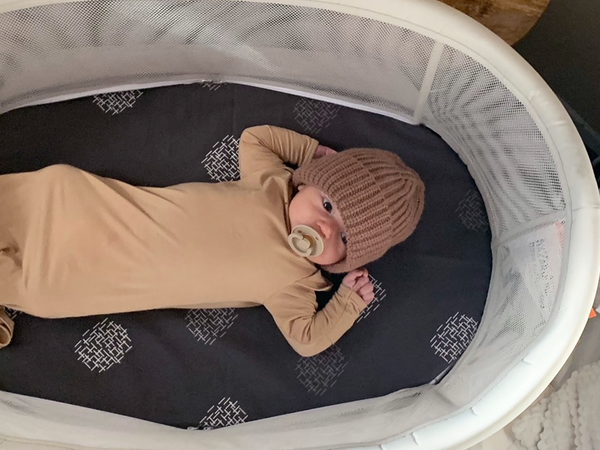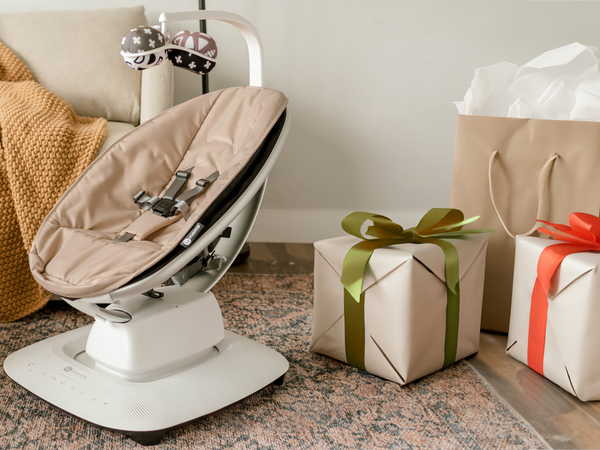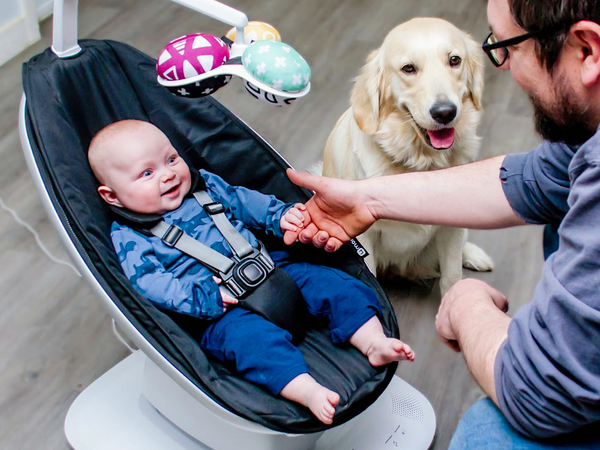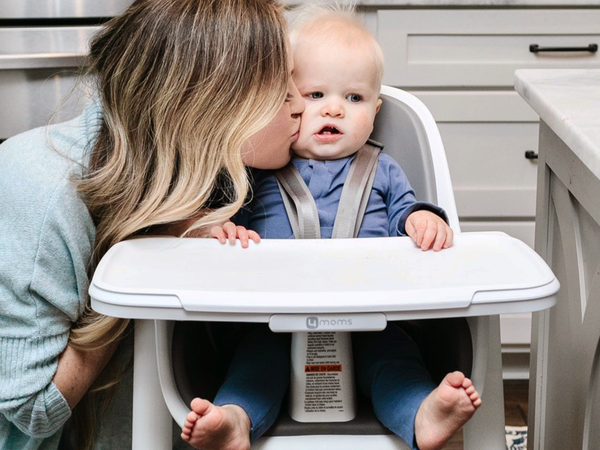How to Get Your Baby to Sleep Without Being Held
The phrase “sleep like a baby” conjures the sweet image of an infant peacefully slumbering in their crib or bassinet. But for many new parents whose baby won't sleep without being held, this image is distressingly far from their reality.
While it’s natural for babies to always want to be in their parent's arms, dealing with a newborn who only sleeps when held is a very real problem for sleep-deprived parents. The popularity of online forums underscore just how desperate parents are to find solutions for how to get their baby to sleep without being held.
In this article, we tackle the science of sleep, explain why a newborn only sleeps when held, and break down sleep training as a solution for how t get your baby to sleep without being held.
Understanding Baby Sleep Patterns
The transition from the womb to the outside world is a jarring one for your baby. In the womb, they’re warm, in constant motion, and soothed by the rhythmic sounds of their mother’s body. But once they’re born, babies are constantly surrounded by the stimuli of their brand new environment and need to establish a healthy sleep-wake cycle.
If your baby won’t sleep unless they're held, it’s important to understand that newborns have very different sleep patterns than older children and adults. They typically sleep from 45 minutes to 3 hours, and they spend more time in rapid eye movement (REM) sleep, which is crucial for brain development. However, their sleep is often fragmented, and they wake frequently for feeding, diaper changes, or cuddles. Being held gives your baby the same feelings of warmth, comfort, and gentle swaying motion they became accustomed to in the womb and helps them relax, feel safe, and transition into a deep and restful sleep.
If your newborn only sleeps when held and wakes up the moment you put them down, you need solutions to help them sleep on their own. The MamaRoo Sleep® Bassinet was designed with the science of infant sleep in mind. With five motions, five speeds, and four different white noise sounds, it can be programmed to recreate the comforting feelings of the womb to ease your baby into a deep and restful sleep.
The Importance of Safe Sleep Practices
Be sure to always follow the American Academy of Pediatrics’ (AAP) safe sleep practices to reduce the risk of Sudden Infant Death Syndrome (SIDS), including:
- Put your baby to sleep on their back on a firm, flat, non-inclined mattress with a fitted sheet.
- Don’t let your baby sleep in gear meant for sitting, such as car seats, strollers, swings, infant carriers, and infant slings.
- Sleep in the same room—but not in the same bed—as your baby, for at least the first six months.
- Keep bumpers, blankets, stuffed animals, and any other items out of your baby’s crib or bassinet.
The MamaRoo Sleep® Bassinet meets all of the AAP’s recommendations for a safe sleep space that still addresses your concerns around a baby who won't sleep unless held: the mattress is firm and flat, plus it has mesh sides for breathability and adjustable legs so you can raise or lower it to the height of your bed, making it easy to keep baby close by while you sleep.
What Do You Do If Your Baby Won't Sleep Without Being Held?
Most babies aren’t born knowing how to fall asleep on their own. If you're still trying to figure out how to get your baby to sleep without being held, all they need is a little nudge in the right direction. These five tips can help:
- Create a predictable bedtime routine that signals to your baby that it’s time to sleep. Choose the routine that works for you; it could be a warm bath in the Cleanwater™ Tub followed by a gentle massage, lullabies, and a short bedtime story.
- Pay attention to your baby’s cues so you learn to recognize when they are about to fall asleep; that way you can put them down when they’re drowsy but still awake so they learn to fall asleep outside of your arms. An automatic rocking bassinet that’s programmed to rock, sway, and bounce your baby to sleep can help even the most sleep-resistant baby learn to gradually fall asleep (and stay asleep) on their own.
- Make sure your baby’s sleep environment is calming and conducive to rest. Maintain a comfortable room temperature, keep lights dim, and play white noise at a low volume to recreate the sounds of the womb. The MamaRoo Sleep® Bassinet is equipped with soothing white noise sounds, which helps even the fussiest baby who won't sleep without being held fall asleep and stay asleep.
- Encourage your baby to find ways to self-soothe, such as sucking on a pacifier or their thumb or rubbing their hair.
- Developing independent sleep habits takes time, so be patient and consistent as your baby learns to fall asleep on their own.
Ensuring a Transition to Independent Sleep
Sleep is the most natural thing in the world, right? When it comes to a newborn who won't sleep at night unless held, the answer is complicated. Your baby’s journey towards independent sleep may be easy or it may be a rocky one. Understanding all the psychological and developmental milestones that are in play as your baby grows can help you to understand why your baby won't sleep unless held, anticipate when it might change, and decide if sleep training is right for your family:
- Newborn Sleep Patterns: During the first few months of life, your baby’s sleep patterns are fragmented, quickly cycling between REM and non-REM sleep. At this point, they lack their own melatonin production and struggle with distinguishing day from night. But take heart, because this stage doesn’t last long and as your baby grows, their sleep patterns will start to become more regular.
- Development of Circadian Rhythms: Around 3 months of age, your baby’s body will start to produce melatonin—and that means sleep patterns will start to become more predictable.
- Object Permanence: Once your baby hits 4 months or 14 pounds, they should weigh enough to make it through the night without a feeding. Your baby will hit some key psychological milestones, such as object permanence—the ability to know that objects (and people) continue to exist even when your baby can’t see or hear them— and that can lead to separation anxiety. As your baby becomes more aware of their surroundings and realizes that you’re not there, it can throw off their sleep patterns. This could then lead to your newborn only sleeping when held. Learning self-soothing techniques can help them overcome their distress at being away from you.
- Choosing the Right Sleep Training Method: Ferberizing. Crying it out. The chair method. There’s a long list of various sleep training methods that you can use. But while the methods may be different, they all have the same goal: Giving your baby the tools they need to self-soothe and fall back asleep independently. As you research all the options that address how to get a newborn to sleep without being held, consult with your pediatrician and pick one that feels comfortable to you and that you can consistently maintain.
- Depending on the method you use for dealing with a baby who only sleeps when held, along with how consistent you are and your baby’s personality, it can take anywhere from a few days to several weeks to sleep train your baby.
- Professional Guidance: Before you start sleep training, talk to your baby’s doctor about any concerns you have and to make sure they’re physically and developmentally ready.
How to Address Common Challenges With A Newborn Who Only Sleeps When Held
You may find that establishing a consistent sleep routine for your baby and learning how to get your baby to sleep without being held is a little like two steps forward and one step back—just as it seems like your baby has fallen into regular sleep patterns, they’ll suddenly start waking up throughout the night or refuse to sleep at their regular bedtime.
While frustrating, these regressions are common and typically occur as your baby is hitting developmental milestones. Take a deep breath because sleep regressions are usually temporary: give your baby some extra cuddles and try to stick to the regular bedtime routine to navigate through these nighttime disruptions and get back on track. And remember that keeping your baby in your room at night, as the CDC recommends, will make it less tiring for you to manage nighttime awakenings while keeping your baby safe.
When to Seek Professional Advice
Typically, sleep is something that will (eventually!) come naturally for all kids, but there are some issues that could mean it’s time to seek professional advice. If you notice any of these signs, schedule some time to talk with your baby’s pediatrician about how to get your newborn to sleep without being held:
- Excessive Fussiness or Crying: If your baby is overtired and unable to settle down for sleep and regular soothing routines aren’t working, it may be time to consult a healthcare provider.
- Disrupted Sleep Patterns: Frequent unexplained nighttime awakenings that disrupt your baby's and family's rest could suggest underlying sleep issues.
- Loud or Disruptive Snoring: Regular snoring that's loud or seems to interfere with your baby's breathing could be a sign your baby has sleep apnea.
- Excessive Daytime Sleepiness: If your baby is unusually drowsy during the day or is excessively sleepy despite getting a good night’s sleep, they could have a sleep disorder.
- Extreme Distress Related to Sleep: Talk to your baby’s pediatrician if they have extreme fear or anxiety around going to sleep or difficulty settling down.
- Persistent Nighttime Bedwetting: Bedwetting is common in babies and young children, but if it continues past the age of 7, you should speak to the pediatrician.
Rest Easy
Sleeping should be easy, and with patience, persistence, and the right tools and methods, your baby that used to only sleep when held will soon be sleeping through the night. If you’re struggling to cope because your newborn won't sleep at night unless held, remember that tools like the MamaRoo Sleep® Bassinet can make the sleep training journey smoother and more comfortable for both baby and parents.

















